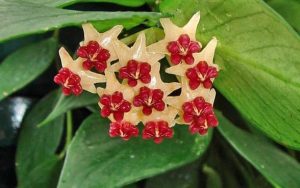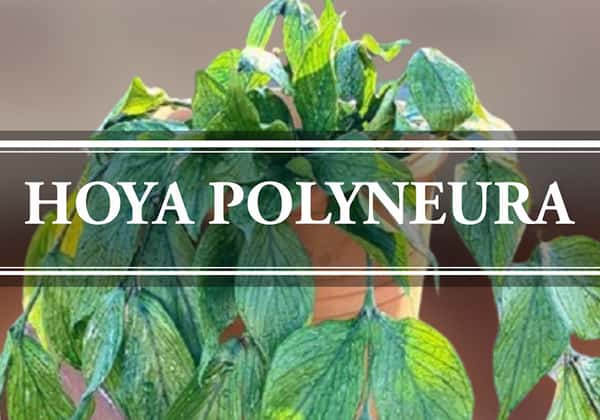The thick, shiny, and waxy leaves of Hoya Plants are quite famous among plant lovers. We are introducing another waxy vine, the Hoya polyneura. The green oval-shaped leaves with prominent veins grow close on long dangling stems. Moreover, these leaves look pretty similar to fishtails, making the plant commonly known as the Fishtail Hoya.
These natives of China and the Himalayas can get about 6 meters long. They are perfect for both indoor and outdoor plantations. Moreover, you can grow them in pots, hanging baskets, and the ground in your yards. Still with us? Let us know more about the care and maintenance of this thin-leafed delicate plant, the Polyneura Hoya.
Hoya polyneura Classification
Family: Apocynaceae (The Dogbane Family)
Genus: Hoya.
Species: H. polyneura.
Genus Hoya:
Hoya was introduced by Robert Brown and named it in the tribute of Thomas Hoy. About 700 evergreen flowering plants along with their cultivars combined to form this genus. Moreover, new species are continuously being added by the botanists.
The most prominent feature of these plants is the waxy thick leaves. Besides, the tiny beautiful flowers grow in the warm season to beautify these flowers. These features refer to these plants commonly known as Wax flowers Plant’, ‘Wax vine’ and ‘Porcelain Flower plant’.
Common Name
The specific shape of the leaves and prominent pattern of thin veins refers to the common name, Hoya polyneura Fishtail.
Hoya polyneura Plant Features

Size:
- The thin delicate vines can get about 2 to 4 meters long on maturity. The length of outdoor vines may get as tall as about 6 meters.
Leaves:
- Leaves are thinner as compared to the majority of the Hoyas. Each mature leaf is about 4 to 6 inches in size.
Flowers:
- The plant shows small clusters of tiny flowers in spring and summer. Each star-shaped flower is white or pale yellow with a purplish center.
Toxicity:
A high concentration of calcium oxalate crystals makes these plants toxic. Close contact can cause skin allergy and itching. Also, ingestion may lead to inflammation of the lips, mouth, and oesophagus.
Where to Grow hoya polyneura:
You can select this classic Hoya for indoor plantation in hanging baskets and pots. Make sure the potted ones have proper support to climb upon. Besides, you can grow them outdoors in warm climates.
Hoya polyneura Care
This delicate plant is easy-to-grow. You can get it for your surroundings without demanding any tedious effort from you.
Quick Guide:
Water: Average (Soak the soil and let it dry out before you water again).
Sunlight: The bright indirect sun.
Humidity: Loves high humidity but tolerates lower moisture levels.
Fertilizer: less concentration in spring and summer.
Water Requirement
These tropical natives like to stay in moist soil. Water the soil to soak it thoroughly and wait for it to get dry before watering again. Make sure you water right after the upper layer gets dry without letting the plant dry out.
You need to understand the drying pattern of the soil to create a watering schedule. Just check the soil with your finger or some stick to check the moisture level in the soil. Estimate the watering frequency of about once or twice a week in spring and summer. On the other hand, once every fourteen to twenty days is enough for the colder days.
Wet and mucky soil is inappropriate for this plant, just like the majority of the Hoyas. Extra water doesn’t let the oxygen to reach the roots causing root rot. So, make sure you are never adding extra water to your plant.
Sunlight Requirement
The fishtail leaves like to stay in bright but indirect light. Make sure you are keeping it a place with plenty of indirect light. However, the delicate foliage is unable to face direct sunlight. Keep them away from direct sun to avoid scorching out the foliage.
Temperature Requirement
The best temperature level for the Hoyas ranges between 50 to 80°F. The delicate foliage has poor tolerance for severe temperature. So, you can not keep them both in very hot and freezing temperatures. Thus, don’t forget to transfer them indoors before the temperature gets fierce in the fall.
Humidity Requirement
The high humidity level shows good results in terms of fresh and lush foliage. Howbeit, these peeps can stay happy in a variety of humidity ranges.
On dry days, the plant may need a little extra care from you. Enhance the moisture level by any of the measures like a pebble-water tray, a humidifier, or grouping of plants. You can mildly mist the plants once in a while to avoid moisture loss. Howbeit, make sure the plant stays well-ventilated and the foliage doesn’t stay wet for long. It is important not to water the flowers.
Soil Requirement
Quick draining and organically rich soil are ideal for the plant. You can use a good quality houseplant mix. Besides, you can mix one part of worm castings and two parts of orchid bark, perlite, and pumice.
Fertilizer Requirements
A regular fertilizer dosage is essential for the healthy growth of the delicate vine. Use a high-quality houseplant fertilizer in spring and summer. Make sure you are using a diluted or low-concentration product. Besides, avoid using intense fertilization as this may scorch out the foliage.
In colder temperatures, the plants don’t need much nutrition. So, you don’t need to fertilize after the end of summer.
Pot Requirements
Hoya plants usually like snug pots. This helps the roots avoid moisture fora longer duration. So, use medium-sized pots with drainage holes at the base to allow drainage.
Pruning Requirements
These quick growing vines need frequent pruning. Remove the older and damaged leaves to enhance the health and outlook of your Hoya.
Growth Zone
USDA Zones 11 and above keep the plant hardy even outdoors. Besides, you can grow them indoors in a range of zones from 4 and above.
Hoya polyneura Propagation
Easy to propagate, these vigorous growers would start turning into new plants with just a little effort.
Propagation by Stem-tip Cutting:
This is the most common and easiest method. If you want to make some new plants, try planting some cuttings in the middle of the spring. The ideal propagating season goes up to the middle of the summer season.
Method
- Cut a few 5 to 8 inches cuttings from the tip of the stems. Remove the leaves from the lower ends keeping the ones at the top.
- Plant these cuttings about 3 inches deeper in some quick-draining moist soil. Make sure you keep the aerial roots under the soil.
- Keep the pot at a spot with indirect light. Also, make sure you water the soil frequently as soon as the upper layer gets dry.
- Roots development will start after a month. Moreover, you will notice baby shoots developing within no time.
Water Propagation:
Instead of soil, you can plant the cuttings in water as well.
- Dip the stem-tip cuttings in a jar of water. Make sure you use filtered water. Tap water can also be used but after staying it open for at least 24 hours. This will evaporate the chlorine and any other toxins.
- Make sure you keep the aerial roots under the water. These will grow out into the roots of the new plant.
- Root and shoot development will start after the first four weeks. Don’t forget to avoid changing the water every week to avoid mucking.
- The cuttings will develop a small root-system after about eight weeks. At this stage, you can transfer the baby plantlets to the soil. These baby plants can also stay in the water and flourish in your water vase.
Related Posts:
Summary
Hoya polyneura is an epiphytic climber belonging to the Apocynaceae family. The vine can get about 3 to 6 meters long depending upon the growing conditions. The dark-green fishtail leaves with prominent veins grow closely on the thin dangling stems.
You can grow this Hoya in pots and hanging baskets. Moreover, these grow equally well outdoors in a moderate climate. Now, let us talk about maintenance. The bases of Holy polyneura Care include bright indirect light and frequent watering. Finally, coming towards the toxicity. Make sure you keep kids and pets away from the Polyneura Plant.

